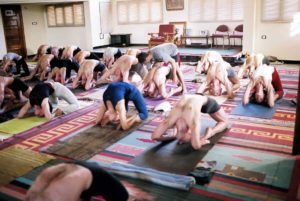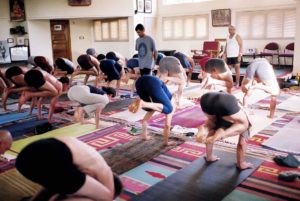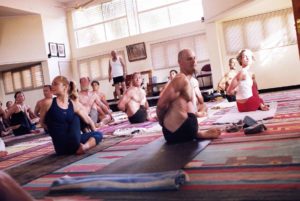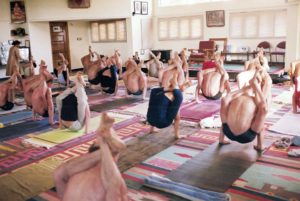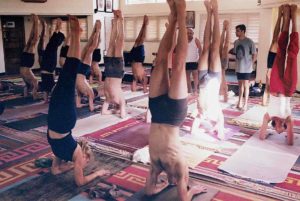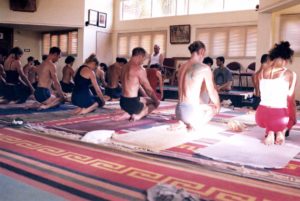Reflections on Learning Ashtanga Asana in the New Millennium
discovering the practice, studying, teaching and travelling
by Philippa Asher
Yoga in some shape or form has been part of my life since childhood. Admittedly I didn’t realise this until I went to university in 1989 and joined the yoga club and I suspect other yoga friends have similar stories. In the early 1970s I discovered a book on my Mum’s bedside table. It was a green paperback called Yoga for Health by Richard Hittleman. The front cover displayed images of ladies in brightly coloured leotards and tights and long flowing hair. Inside were illustrations of fabulous stretches and twists. As a three year old I adored this book and had a wonderful time mimicking the shapes, or at least my interpretation of them! I also enjoyed sitting quietly (which was probably an attempt to ignore my older siblings), but it felt like the right thing to do.
Joining the yoga club followed my purchasing (for the princely sum of five pence at a secondhand book sale in the Students’ Union), a copy of Light on Yoga by BKS Iyengar. I can remember leafing through the pages and laughing hysterically at all the body contortions and balances. Little did I know what the Universe had in store …
After finishing my degree and post grad, I moved to Brixton. I can’t even remember what enticed me to join the local yoga class near the Lido. The style was different from that which I’d learned at university and I soon found myself attending regular Ashtanga yoga classes in a newly opened yoga centre in North London. My interest grew at a steady pace and within a few months I had learned the Primary Series asanas. As my mind and body became stronger and more open, I began to feel more in tune with who I really am and acknowledged aspects of my life that did not resonate with me. The practice furnished me with the courage to make changes.
I studied Dance Anthropology, History and Performance at university, so felt a need to go to the source in India, to learn directly from the guru. With a bit of encouragement from my incredible boss in Media, the following sixteen years of annual trips to Mysore (to study for three to six months a year), under the guidance of Guru Sri K Pattabhi Jois and his grandson Sharath began.
India can be overwhelming with the heat, colours, noise, traffic, rubbish, pollution, chaos, the sheer amount of people, imbalance of wealth, lack of personal space and poverty, but most of all it felt like I was going back in time. The Cauvery Lodge where I stayed on my first trip, was beyond basic and India seemed stuck in the 1950s. I was homesick. When I met Pattabhi Jois with his warm smile and sparkling eyes, I knew that I couldn’t abscond straight away. Guruji’s Laxmipuram shala was small and twelve people could practise at a time. Students received optimum attention and guidance and Sharath was there too. This effective model of small classes and quality teaching has stayed with me and is how I prefer to share the method. When the amount of students descending upon Mysore began to escalate significantly, Guruji built a large shala in Gokulam (a suburb of Mysore). The new space could comfortably take fifty students and was generally open all year round. As before, we would send a letter stating our arrival and departure dates and both Saraswathi and Sharath assisted Guruji in the shala. Certain months of the year were busier than others and I soon realised that if I came during the Indian monsoon, there were fewer of us in class. I feel incredibly blessed to have learned the Ashtanga asana practice directly from Guruji. I asked him once why the practice seemed to have evolved from what was being taught in the Seventies and Eighties. He said that by the end of the Nineties, the different ‘series’ had been set. His shala was humbly called the Ashtanga Yoga Research Institute and this suggests that he was still learning and experimenting with the asana system, until he was happy with the way that it was being practised and taught. It is only after his passing, that the name changed to KPJ Ashtanga Yoga Institute, a centre dedicated to honouring Guruji’s method. Sharath and Saraswathi continue to share the asana practice in Mysore, respecting Guruji’s teachings.
Patañjali’s Yoga Sutras opens with … now begins the practice of yoga (so you must be prepared and ready: receptive, disciplined, determined, dedicated, open, strong, balanced and humble). Quite honestly I was not ready until my late twenties, as I had a lot of living and experiencing to do, before I could focus my mind on a serious discipline. Even then, it took me another seven years to understand what that actually meant. The way that Guruji and Sharath taught me asana, was that I needed to be able to demonstrate each posture with a decent level of proficiency, strength, flexibility, grace, humility and calmness, before learning the next. The standard was high and the practice was difficult. There were no short cuts, it was sheer hard graft and one pointed focus and determination to keep working on each asana until the body, mind and breath allowed a posture to manifest. Sometimes I was kept on an asana for months on end, until Guruji or Sharath decided that I was ready to learn the next one. This discipline is the essence of the way that I learned the Ashtanga method. The practice is about making the mind and body open and strong and not giving up (or finding excuses), when faced with something challenging. We have to enquire within, explore and experiment with each challenging posture, until tristhana unfolds. I never saw Guruji teach with props, or give modifications for postures, nor did I see him add in additional preparations or movements that were not in the vinyasa sequence. We had to master each asana before learning the next and everyone respected his ‘correct method’ and understood why this is heart of the Ashtanga asana system. If done correctly, the asanas work harmoniously on many different layers: physical, energetic, mental, emotional and blissful.
It took me fifteen consecutive years of study at KPJAYI to learn the Primary, Intermediate, Advanced A and Advanced B Series (that’s an aggregate of around forty five months in the shala with Guruji and Sharath). I wasn’t Authorised to teach until I had started learning the Advanced B Series and was Certified by Guruji two years later. When I learned with Pattabhi Jois, he would only Authorise students after they had completed (with proficiency), at least the Primary and Intermediate Series and had studied with him for twelve or more months (over three or four years). Authorised students had to demonstrate not only their understanding and competence in asana, but also their commitment to paramapara and an aptitude to sharing the method and preserving the lineage. They were also required to return every eighteen months to continue their study and to renew their Authorisation. Certified teachers were expected to have completed (with proficiency) at least the Primary, Intermediate and Advanced A Series, have studied with Guruji for around thirty six months (over eight or more years), demonstrate an aptitude for sharing the method and a commitment to paramapara (honouring the responsibility to practise and teach how Guruji taught us and to preserve his method).
I never imagined that I would end up sharing the Ashtanga system. I practised asana and trying to be a kind-natured person because it made me happy and I loved going to Mysore to study with Guruji because he was full of joy. I adored the vibe in the shala and the people who practised there. Every year or so, we left our busy lives and flew to India to study with Guruji because of our devotion to him and his amazing method. When Guruji Certified me to teach in 2008, I saw it as an enormous responsibility “You teach how I taught you”, he said. Words that resonate with me every day. Guruji connected with people, he was vibrant, kind, generous, made people smile and lived to share the practice. He was also strict, had high standards and was incredibly disciplined. He had a wonderful balance of firmness and joy. I would not have felt ready to share the Ashtanga system before I had Guruji’s blessing to teach. He was intuitive, supportive and wanted his students to have completely understood their craft to the best of their ability, before sharing it. This is part of paramapara. Guruji only wanted us to teach what we know and to not attempt to share and assist postures that we cannot execute with grace and proficiency ourselves. Certified teachers only teach up to the final asana that they have learned with Guruji or Sharath.
Had I not completed a post grad in the Education of Adults at university, I would not have acquired the teaching skills and confidence to share the method. Practising asana and teaching are very different disciplines. Not only did we develop practical teaching skills, how to effectively facilitate learning, manage a room and deal with all kinds of situations, we also learned about the psychology of learning, educational theory, how to read people and how different personalities respond to various teaching techniques. To give you an idea of how seriously pedagogy was taken by psychologists at Surrey University, when my course director introduced our psychology professor as Ben Elton’s dad, Professor Elton responded ‘I would far rather be known for who I am.’
The easiest way to discover yoga for most people, is through the practise of postures. It was the asana system of Sri K Pattabhi Jois that captured my attention. I loved the dynamic sequences that work so deeply on the whole body, whilst at the same time forcing the practitioner to concentrate, breathe deeply and be calm. I loved the feeling of euphoria at the end of class. The Ashtanga method shattered all my earlier preconceptions of yoga, which was something that middle class Mums did in the village hall, or dropout hippies with long hair. This system with its many facets, was something way more powerful than I could have possibly imagined, working not only on the physical body, but on the mind, breath and nervous system.
Even today the Eight Limbs of Ashtanga yoga (as outlined in Patañjali’s two thousand year old text Yoga Sutras) seem to be a sensible and practical guide to being a dignified, kind, ethical, compassionate, balanced, happy and healthy human being. Asana (the third limb) is described as steadiness and ease (II, 46), so in order to perform a posture correctly, the mind, body and breath need to be calm, still and at ease. In the tradition of Sri K Pattabhi Jois, one has to master tristhana: the perfect synchronisation of the breath (to clean the nervous system), gaze points (to still the mind) and movement (to cleanse the physical body) and the correct physical alignment in each asana (so that prana can flow freely and we don’t get injured), before a posture will reveal itself. Once this attention to detail, focus and discipline have been absorbed and honoured, yoga can happen and the other limbs transpire organically. It’s a very elegant system.
The first two limbs (ethical and personal behavioural codes) fall into place as the body and mind become open, strong, free from ‘dis’ ease and undigested emotions: non-violence, truthfulness, non-stealing, appropriate behaviour in relationships, non-grasping … cleanliness, contentment, self-discipline, mindful study and trust that if you’re truly on the right path, the Universe will guide you. Postural practice and breath control (the third and forth limbs) are practical techniques for cleaning, opening, strengthening and balancing the body, breath and mind and the last four limbs (control of the senses, concentration, meditation and absorption) are to do with focusing the mind, stimulating internal awareness and being connected, still, peaceful and free from attachment, emotions and afflictions that cause the mind to be agitated. The Yoga Sutras disclose that ‘yoga happens when fluctuations of the mind cease’ (I,2) and ‘those fluctuations are overcome by meditation’ (II,2). At the core of the practice is mind control, discipline, courage, peace and joy.
After I had been to Mysore a few times to study with Guruji and had started learning the Advanced A Series with him, I began assisting my London teacher. Apprenticing with a Certified teacher and learning how to assist under their guidance is a safe and traditional way of discovering how to share the Ashtanga method. It is only by studying practitioners, their bodies and the many different ways of executing asana that one can begin to intuitively work with others and understand how to effectively help them in an unobtrusive manner. One does need to have an established, proficient daily postural practice in order to understand the asanas, offer valuable verbal guidance, clean demonstrations and effective adjustments.
I received my Authorisation from Guruji in 2006 and started to teach my own classes. I set up and ran a busy Ashtanga guided self-practice programme in Soho for six years, before relocating to South India to build my own Ashtanga yoga retreat. The dream was to create a magical place in an idyllic setting where I can focus on teaching small groups of practitioners, feel connected to nature, eat amazing plant-based food and embrace all eight limbs of Ashtanga yoga. This little piece of paradise is ASHTANGA NIRVṚTA and it is truly wonderful. We offer two week Ashtanga yoga retreats from January to May every year.
When not at my retreat in India, I teach the Ashtanga method in Europe, Asia and the Middle East. I feel blessed to have the opportunity to connect with practitioners from many different countries and to see how the practice is being shared and practised worldwide.
When I was first exposed to the Ashtanga method in the late 1990s there were not many Certified and Authorised Ashtanga yoga teachers. The standard was high with many months of contact time with Guruji and Sharath in Mysore, over several years. Even today there are fewer than forty KPJAYI Certified teachers worldwide. There has been a boom in newly Authorised students under the Level 1 and Level 2 system that was introduced after Gurui’s passing. When Guruji was with us, he encouraged practitioners to return to Mysore regularly to honour paramapara and to continue studying with him. Many of us still go back to Mysore whenever we can, to touch base with the source (and to ensure that our teaching and practice are current and that we’re not disremembering things). However, as there are many more students practising at KPJAYI now and the shala isn’t open all year round, not everyone is guaranteed a place.
The promise that I made to Guruji (and I’m guessing others too), was simple. It was to pass on the practice in the same way that he shared it with us. Everyone’s reality and interpretation of his teaching will be different of course, but generally I think he meant teach the guided self-practice method (with led classes to emphasise the count), don’t change things and be firm, yet kind. My understanding is that he didn’t want us to run teacher training courses, invent led classes called level 1, 2, 3 (where students follow and attempt postures that they are not physically and emotionally ready for), advocate the use of props, or add extra movements and extraneous exercises that aren’t part of the sequence. I also think he expected us to honour his method of only sharing new asanas with students, once they had mastered the previous ones and were physically and emotionally ready to learn the next one and to teach what Guruji called ‘correct method’. From what I saw, those with his blessing to share the system had a solid understanding of the practice and were able to demonstrate, with proficiency the asanas that they were allowed to teach. Most practitioners seemed to have a dedicated daily Ashtanga practice for at least seven years, before beginning to assist others. This standard allowed practitioners to be good students for many years and to develop a sound understanding of the practice before embracing the responsibility that comes with teaching. Continuing to read scriptures and texts on yoga philosophy and absorbing the eight limbs into our daily life, are a given as part of our ongoing journey.
The worldwide surge in popularity of the Ashtanga method and the amount of students practising and wanting to share the system (or an interpretation of it) before being suitably experienced, means that it is easy for quirks to manifest. This can also be the case if established practitioners tweak the method, or students are encouraged to attempt too many postures, incorrectly and before they are ready. These quirks can result in confusion, injury and instability in students’ physical and emotional well-being. Perhaps a helpful benchmark (whether practising or teaching) might be to consider ‘if Guruji was watching right now, what would he say?’
We all practise for different reasons and with time the Ashtanga method can help us to feel connected. The teacher is there to support, guide and at times, lead students from darkness into light. When the yoga is working, we feel more ordinary and connected, as it brings us back to our natural state, or our True Self. When it is not working we feel extraordinary and disconnected, as the inflated ego (false self) takes over …
Now of course we are in the age of social media and and ‘self’ promotion (which might be seen as the antithesis of surrendering the ego). Pin-up practitioners can choose to have images of themselves and their names displayed before the yoga and share beautifully choreographed photos in non-practice settings. Online tutorials and YouTube clips can offer a plethora of postural displays, which might encourage students to learn the practice rather quickly or in a gung-ho fashion, without the guidance and watchful eye of a skilled teacher. Like other hatha yoga texts that Guruji’s teacher Krishnamacharya referred to, Yoga Rahasya advises ‘The guru is vital in the learning of yoga. Learning yoga without a gifted teacher may harm the student, instead of elevating him.’ (1:8)
The internet has of course been instrumental in accelerating the explosion of Ashtanga yoga and provides an incredible platform for sharing many helpful and discerning resources on asana, the practice and where to find teachers, as well as wonderful footage of Krishnamacharya, Pattabhi Jois, Mr Iyengar, Sharath (and many more) practising and teaching. These can offer valuable insights and tips into the mindful execution of the postural and breathing practice. Now practitioners all over the globe can enjoy increasing their knowledge and understanding of yoga through accessing texts on yoga philosophy and hatha yoga, which have been transliterated and translated into English. Practise sheets, books and films are now in abundance and can be downloaded or purchased, in seconds.
The post Millennium era is unravelling many interesting aspects. The popularity of Ashtanga asana and yoga and the rapidly increasing amount of practitioners all over the world is a testament to Guruji’s remarkable method. May there continue to be many dedicated practitioners and teachers worldwide, who do their best to preserve the Ashtanga asana practice, so that as they come and go, Guruji’s powerful method lives on for generations to come.
© 2017 Philippa Asher
Led Intermediate class with Guruji, Sharath and Saraswathi at AYRI (now KPJAYI) in Mysore, circa 2004. KPJAYI has since been renamed Sharath Yoga Centre. Photos by Itay Dollinger

